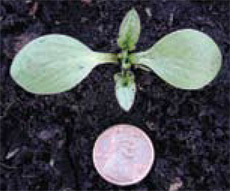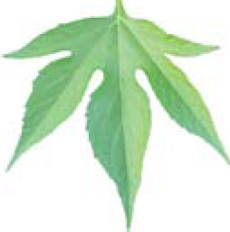Giant ragweed
June 11, 2015
Ambrosia trifida L. Asteraceae (Aster family)
Life cycle
Erect, branching summer annual.

Young giant ragweed plant.
Leaves
Cotyledons are thick and oval to spatula-shaped and differ from those of common ragweed by being three to four times larger. Initial leaves are entire; successive leaves have three to five lobes and leaves are opposite in arrangement. Leaves are hairy and rough.


Giant ragweed seedling (left) and leaf (right).
Stems
Usually hairy and rough to touch, erect and branched and up to 15 feet in height.
Flowers and fruit
Flowers are generally inconspicuous, found on terminal branches. They produce prolific amounts of pollen. The seed is enclosed in a single-seeded, woody fruit with five spikes encircling a long point, resembling a crown. Seeds are found in the axils of the upper leaves

Giant ragweed flowering branch.
Reproduction
Seeds.
Print a PDF of this page: Giant ragweed



 Print
Print Email
Email




